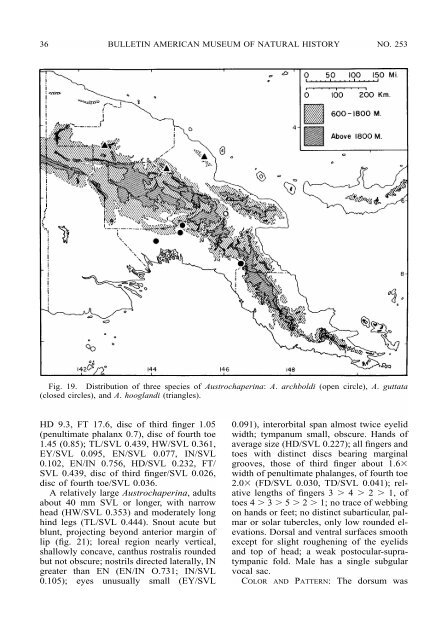SPHENOPHRYNE - American Museum of Natural History
SPHENOPHRYNE - American Museum of Natural History
SPHENOPHRYNE - American Museum of Natural History
You also want an ePaper? Increase the reach of your titles
YUMPU automatically turns print PDFs into web optimized ePapers that Google loves.
36 BULLETIN AMERICAN MUSEUM OF NATURAL HISTORY NO. 253<br />
Fig. 19. Distribution <strong>of</strong> three species <strong>of</strong> Austrochaperina: A. archboldi (open circle), A. guttata<br />
(closed circles), and A. hooglandi (triangles).<br />
HD 9.3, FT 17.6, disc <strong>of</strong> third finger 1.05<br />
(penultimate phalanx 0.7), disc <strong>of</strong> fourth toe<br />
1.45 (0.85); TL/SVL 0.439, HW/SVL 0.361,<br />
EY/SVL 0.095, EN/SVL 0.077, IN/SVL<br />
0.102, EN/IN 0.756, HD/SVL 0.232, FT/<br />
SVL 0.439, disc <strong>of</strong> third finger/SVL 0.026,<br />
disc <strong>of</strong> fourth toe/SVL 0.036.<br />
A relatively large Austrochaperina, adults<br />
about 40 mm SVL or longer, with narrow<br />
head (HW/SVL 0.353) and moderately long<br />
hind legs (TL/SVL 0.444). Snout acute but<br />
blunt, projecting beyond anterior margin <strong>of</strong><br />
lip (fig. 21); loreal region nearly vertical,<br />
shallowly concave, canthus rostralis rounded<br />
but not obscure; nostrils directed laterally, IN<br />
greater than EN (EN/IN O.731; IN/SVL<br />
0.105); eyes unusually small (EY/SVL<br />
0.091), interorbital span almost twice eyelid<br />
width; tympanum small, obscure. Hands <strong>of</strong><br />
average size (HD/SVL 0.227); all fingers and<br />
toes with distinct discs bearing marginal<br />
grooves, those <strong>of</strong> third finger about 1.6<br />
width <strong>of</strong> penultimate phalanges, <strong>of</strong> fourth toe<br />
2.0 (FD/SVL 0.030, TD/SVL 0.041); relative<br />
lengths <strong>of</strong> fingers 3 4 2 1, <strong>of</strong><br />
toes 4 3 5 2 1; no trace <strong>of</strong> webbing<br />
on hands or feet; no distinct subarticular, palmar<br />
or solar tubercles, only low rounded elevations.<br />
Dorsal and ventral surfaces smooth<br />
except for slight roughening <strong>of</strong> the eyelids<br />
and top <strong>of</strong> head; a weak postocular-supratympanic<br />
fold. Male has a single subgular<br />
vocal sac.<br />
COLOR AND PATTERN: The dorsum was
















